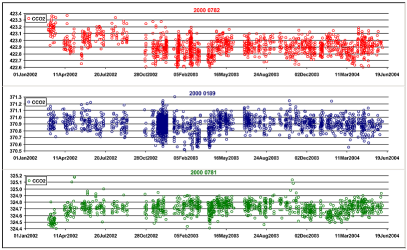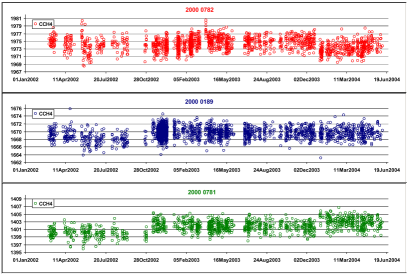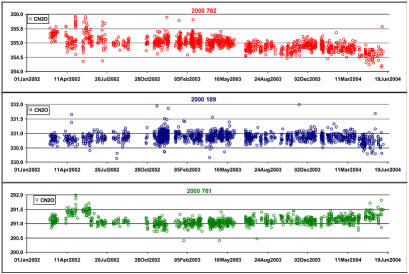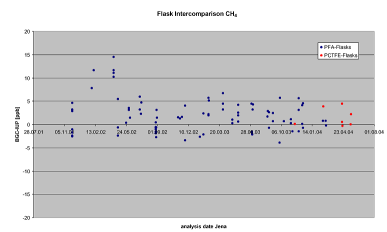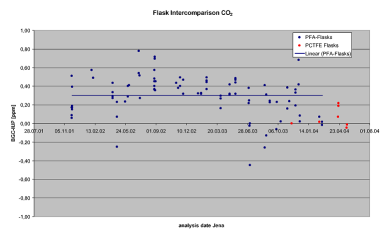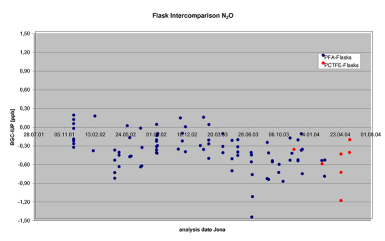|
A chromatographic run starts with flushing sample gas through the two sample loops. The amount of gas is controlled by a mass flow controller. After equilibration with ambient pressure the loop gases are injected onto the respective precolumn using Valco 10 port injection valves. After the analytes have passed the precolumn and entered the main GC-column the Valco 10 port valves are switched again to backflush the precolumns. Injections are made alternatingly between sample gas and one reference gas ("working standard"). The ratio of a sample analysis and the mean of the two bracketing working standard analysis is calculated for quantification. With this approach we achieve average relative precisions of 0.07% for CH4 (1.3 ppb at atmospheric mixing ratio levels), 0.02 % for CO2 (0.08 ppm), 0.04% for N2O (0.13 ppb), 0.3 % for CO (0.5 ppb), 0.5% for SF6 (0.03 ppt) and 0.4% for H2 (2 ppb). Calibration and concentration scales In addition to the instrumental setup the analytical procedure for trace gas analysis also includes the development of calibration strategies for each of the compounds. The calibration scale for each compound is set using standard gases calibrated by reference laboratories that can determine the trace gas of interest using an absolute method or have a proven long-term calibration record.  CO2. In compliance with recommendations of the 11th WMO/IAEA CO2 Experts Meeting the CO2Subscript calibration scale for measurements of atmospheric samples has been directly linked to the WMO mole fraction scale. Although the CO2 calibration curve with the GC-FID is linear within the range set by these calibration standards it cannot be extrapolated to higher concentrations that are found in soil gas samples as the linear range is limited by the methanizer capacity. In order to link soil gas data to the atmospheric data an extended calibration curve based on the atmospheric scale has been derived by precisely mixing a high concentration reference gas with synthetic air using a gas divider (GASMAN 210, Sircal Inc., Sutton, UK). The precision of the dilution process has been checked by simultaneous analysis of CH4 with the FID (assuming a linear response) and was found to be better than 0.5 %. Response curve of the RGA. The response of the RGA detector shows a strong non-linearity especially in the low-concentration range that is difficult to calibrate with a limited number of reference standards. Therefore, the detector response curve was established with two independent experiments. Nine glass flasks were filled with standard gas and diluted with synthetic air purified with a Sofnocat (Molecular Products, Thaxted, UK) cartridge. The dilution factor was determined using a high precision manometer (0.5 % accuracy). A second set of dilution series was made using a GASMAN 210 gas divider (Sircal Inc., Sutton, UK) that mixes two gases through a parallel network of 10 identical flow restrictors. Using a cubic regression fit the residuals for all calibration points are within 5 ppb for H2. A systematic deviation from the cubic fit is observed in the case of CO, where the detector response can be described best using a function of the type f = a�x+bx+c+exf. CO. The calibration scale for CO is based on five high-pressure aluminium tanks (Luxfer) filled and calibrated by CSIRO in 1999. As CO mixing ratios in these cylinders may be instable an additional cylinder was calibrated with an absolute method by C. Brenninkmeijer, MPI for Chemistry, Mainz in 2002. Within the quoted precision limits of both calibrations (1.5 ppb at 163.5 ppb) there was no evidence for a CO drift in the CSIRO cylinders over that period of time. H2. Commonly used high pressure aluminium cylinders normally grow hydrogen over time which disqualifies them as standard gas containers. An exceptionnally well behaving batch of cylinders from Scott Marrin was identified by DAR-CSIRO. One of the selected cylinders was kindly provided to BGC-GasLab with an air standard with calibrated hydrogen concentration (542.3 ppb). This cylinder was used to transfer the CSIRO hydrogen scale. Stainless steel is known to exhibit superior properties with respect to hydrogen stability. Therefore, the BGC-Gaslab scale is fixed by additional standards of reference air that have been filled in two 50 L high pressure stainless steel cylinders manufactured by Linde and in three 35 L stainless steel containers manufactured by Essex Cryogenics. All tanks have been electropolished internally. Performance Results] A major task of BGC-GasLab activities remains the assurance of longterm consistency and international comparability of results and quality assurance (QA). The quality of daily analyses is routinely monitored by measurement of QA standard gases with different trace gas concentrations. This protocol provides a performance record of the analytical precision. It also serves to indicate instrumental failures as well as drifts in trace gas concentrations of individual standard gases at an early stage. Intercomparison Programs (ICPs) As an external check BGC-GasLab participates in intercomparison programs. Sample air of shared flasks are regularly analysed by BGC-Gaslab and the Institute of Environmental Physics, University of Heidelberg (Ingeborg Levin) and with CSIRO (quaterly). BGC Gaslab is also participating in an ICP with flasks filled in series ("sausage flasks") within the TACOS framework (bimonthly six flasks): The collaborating laboratories are IUP, LSCE, CIO, NIES, CSIRO.    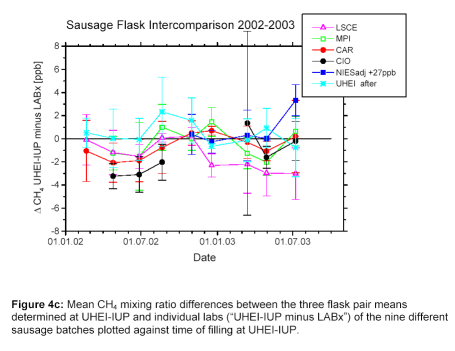 |
